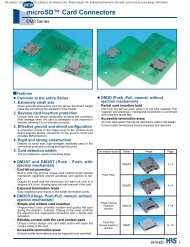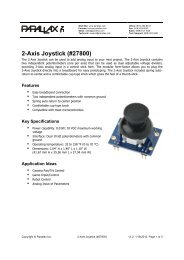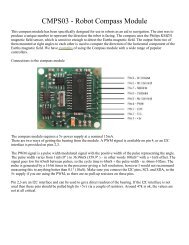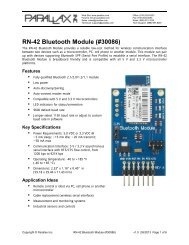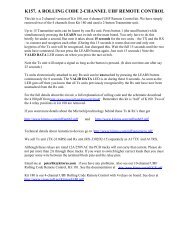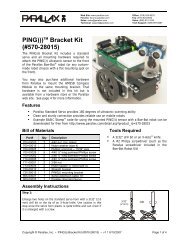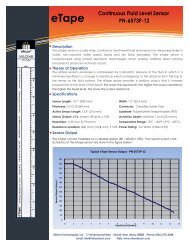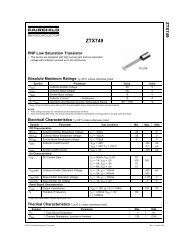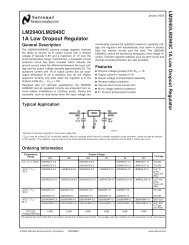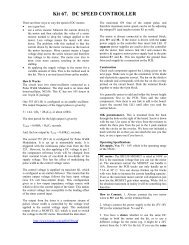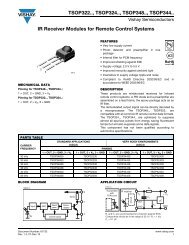256 I2C CMOS Serial EEPROM
256 I2C CMOS Serial EEPROM
256 I2C CMOS Serial EEPROM
- No tags were found...
You also want an ePaper? Increase the reach of your titles
YUMPU automatically turns print PDFs into web optimized ePapers that Google loves.
24AA<strong>256</strong>/24LC<strong>256</strong>/24FC<strong>256</strong>1.0 ELECTRICAL CHARACTERISTICSAbsolute Maximum Ratings†VCC............................................................................................................................................................................6.5 VAll inputs and outputs w.r.t. VSS ....................................................................................................... -0.6 V to VCC +1.0 VStorage temperature ...............................................................................................................................-65°C to +150°CAmbient temp. with power applied ..........................................................................................................-65°C to +125°CESD protection on all pins ......................................................................................................................................................≥ 4kV† NOTICE: Stresses above those listed under “Maximum Ratings” may cause permanent damage to the device. Thisis a stress rating only and functional operation of the device at those or any other conditions above those indicated inthe operational listings of this specification is not implied. Exposure to maximum rating conditions for extended periodsmay affect device reliability.1.1 24AA<strong>256</strong>/24LC<strong>256</strong>/24FC<strong>256</strong> DC Electrical SpecificationsDC SpecificationsElectrical Characteristics:Industrial (I): VCC = +1.8 V to 5.5 V TAMB = -40°C to +85°CAutomotive (E): VCC = +2.5 V to 5.5 V TAMB = -40°C to +125°CParam.No.Sym Characteristic Min Max Units ConditionsD1 — A0, A1, A2, SCL, SDA — — — —and WP pins:D2 VIH High level input voltage 0.7 VCC — V —D3 VIL Low level input voltage — 0.3 VCC0.2 VCCD4 VHYS Hysteresis of SchmittTrigger inputs(SDA, SCL pins)VVVCC ≥ 2.5 VVCC < 2.5 V0.05 VCC — V VCC ≥ 2.5 V (Note)D5 VOL Low level output voltage — 0.40 V IOL = 3.0 ma @ VCC = 4.5 VIOL = 2.1 ma @ VCC = 2.5 VD6 ILI Input leakage current — ±10 µA VIN = VSS or VCC, WP = VSSVIN = VSS or VCC, WP = VCCD7 ILO Output leakage current — ±10 µA VOUT = VSS or VCCD8 CIN,COUTPin capacitance(all inputs/outputs)— 10 pF VCC = 5.0 V (Note)TAMB = 25°C, fC = 1 MHzD9 ICC Read Operating current — 400 µA VCC = 5.5 V, SCL = 400 kHzICC Write — 3 mA VCC = 5.5 VD10 ICCS Standby current — 1 µA TAMB = -40°C to +85°CSCL = SDA = VCC = 5.5 VA0, A1, A2, WP = VSS— 5 µA TAMB = -40°C to +125°CSCL = SDA = VCC = 5.5 VA0, A1, A2, WP = VSSNote: This parameter is periodically sampled and not 100% tested.DS21203J-page 2 Preliminary © 2002 Microchip Technology Inc.
24AA<strong>256</strong>/24LC<strong>256</strong>/24FC<strong>256</strong>1.2 24AA<strong>256</strong>/24LC<strong>256</strong>/24FC<strong>256</strong> AC Electrical SpecificationsAC SpecificationsParam.No.Electrical Characteristics:Industrial (I): VCC = +1.8 V to 5.5 V TAMB = -40°C to +85°CAutomotive (E): VCC = +2.5 V to 5.5 V TAMB = -40°C to +125°CSym Characteristic Min Max Units Conditions1 FCLK Clock frequency ———2 THIGH Clock high time 40006005003 TLOW Clock low time 470013005004 TR SDA and SCL rise time (Note 1) ———5 TF SDA and SCL fall time (Note 1) ——6 THD:STA START condition hold time 40006002507 TSU:STA START condition setup time 47006002501004001000——————10003003003001008 THD:DAT Data input hold time 0 — ns (Note 2)9 TSU:DAT Data input setup time 25010010010 TSU:STO STOP condition setup time 400060025011 TSU:WP WP setup time 400060060012 THD:WP WP hold time 47001300130013 TAA Output valid from clock (Note 2) ———14 TBUF Bus free time: Time the bus mustbe free before a new transmissioncan start15 TOF Output fall time from VIHminimum to VIL maximumCB ≤ 100 pF16 TSP Input filter spike suppression(SDA and SCL pins)47001300500——————————————————3500900400———10 + 0.1CB 25025017 TWC Write cycle time (byte or page) — 5 ms —kHznsnsnsnsnsnsnsnsnsnsnsns1.8 V ≤ VCC < 2.5 V2.5 V ≤ VCC ≤ 5.5 V2.5 V ≤ VCC ≤ 5.5 V 24FC<strong>256</strong>1.8 V ≤ VCC < 2.5 V2.5 V ≤ VCC ≤ 5.5 V2.5 V ≤ VCC ≤ 5.5 V 24FC<strong>256</strong>1.8 V ≤ VCC < 2.5 V2.5 V ≤ VCC ≤ 5.5 V2.5 V ≤ VCC ≤ 5.5 V 24FC<strong>256</strong>1.8 V ≤ VCC < 2.5 V2.5 V ≤ VCC ≤ 5.5 V2.5 V ≤ VCC ≤ 5.5 V 24FC<strong>256</strong>All except, 24FC<strong>256</strong>2.5 V ≤ VCC ≤ 5.5 V 24FC<strong>256</strong>1.8 V ≤ VCC < 2.5 V2.5 V ≤ VCC ≤ 5.5 V2.5 V ≤ VCC ≤ 5.5 V 24FC<strong>256</strong>1.8 V ≤ VCC < 2.5 V2.5 V ≤ VCC ≤ 5.5 V2.5 V ≤ VCC ≤ 5.5 V 24FC<strong>256</strong>1.8 V ≤ VCC < 2.5 V2.5 V ≤ VCC ≤ 5.5 V2.5 V ≤ VCC ≤ 5.5 V 24FC<strong>256</strong>1.8 V ≤ VCC < 2.5 V2.5 V ≤ VCC ≤ 5.5 V2.5 V ≤ VCC ≤ 5.5 V 24FC<strong>256</strong>1.8 V ≤ VCC < 2.5 V2.5 V ≤ VCC ≤ 5.5 V2.5 V ≤ VCC ≤ 5.5 V 24FC<strong>256</strong>1.8 V ≤ VCC < 2.5 V2.5 V ≤ VCC ≤ 5.5 V2.5 V ≤ VCC ≤ 5.5 V 24FC<strong>256</strong>1.8 V ≤ VCC < 2.5 V2.5 V ≤ VCC ≤ 5.5 V2.5 V ≤ VCC ≤ 5.5 V 24FC<strong>256</strong>1.8 V ≤ VCC < 2.5 V2.5 V ≤ VCC ≤ 5.5 V2.5 V ≤ VCC ≤ 5.5 V 24FC<strong>256</strong>ns All except, 24FC<strong>256</strong> (Note 1)24FC<strong>256</strong> (Note 1)— 50 ns All except, 24FC<strong>256</strong> (Notes 1 and 3)18 — Endurance 1,000,000 — cycles 25°C (Note 4)Note 1: Not 100% tested. CB = total capacitance of one bus line in pF.2: As a transmitter, the device must provide an internal minimum delay time to bridge the undefined region (minimum 300 ns) of the fallingedge of SCL to avoid unintended generation of START or STOP conditions.3: The combined TSP and VHYS specifications are due to new Schmitt trigger inputs, which provide improved noise spike suppression. Thiseliminates the need for a TI specification for standard operation.4: This parameter is not tested but ensured by characterization. For endurance estimates in a specific application, please consult the TotalEndurance Model, which can be obtained on Microchip’s website: www.microchip.com.© 2002 Microchip Technology Inc. Preliminary DS21203J-page 3
24AA<strong>256</strong>/24LC<strong>256</strong>/24FC<strong>256</strong>2.0 PIN DESCRIPTIONSThe descriptions of the pins are listed in Table 2-1.TABLE 2-1:NamePIN FUNCTION TABLE8-pinPDIP8-pinSOIC8-pinTSSOP14-pinTSSOP8-pinMSOP8-pinDFNFunctionA0 1 1 1 1 — 1 User Configurable Chip SelectA1 2 2 2 2 — 2 User Configurable Chip Select(NC) — — — 3, 4, 5 1,2 — Not ConnectedA2 3 3 3 6 3 3 User Configurable Chip SelectVSS 4 4 4 7 4 4 GroundSDA 5 5 5 8 5 5 <strong>Serial</strong> DataSCL 6 6 6 9 6 6 <strong>Serial</strong> Clock(NC) — — — 10, 11, 12 — — Not ConnectedWP 7 7 7 13 7 7 Write Protect InputVCC 8 8 8 14 8 8 +1.8 V to 5.5 V (24AA<strong>256</strong>)+2.5 V to 5.5 V (24LC<strong>256</strong>)+2.5 V to 5.5 V (24FC<strong>256</strong>)2.1 A0, A1, A2 Chip Address InputsThe A0, A1 and A2 inputs are used by the 24XX<strong>256</strong> formultiple device operations. The levels on these inputsare compared with the corresponding bits in the slaveaddress. The chip is selected if the compare is true.For the MSOP package only, pins A0 and A1 are notconnected.Up to eight devices (two for the MSOP package) maybe connected to the same bus by using different chipselect bit combinations. If these pins are left unconnected,the inputs will be pulled down internally to VSS.If they are tied to VCC or driven high, the internal pulldowncircuitry is disabled.In most applications, the chip address inputs A0, A1and A2 are hard-wired to logic ‘0’ or logic ‘1’. For applicationsin which these pins are controlled by a microcontrolleror other programmable device, the chipaddress pins must be driven to logic ‘0’ or logic ‘1’before normal device operation can proceed.2.2 <strong>Serial</strong> Data (SDA)This is a bi-directional pin used to transfer addressesand data into and out of the device. It is an open drainterminal. Therefore, the SDA bus requires a pull-upresistor to VCC (typical 10 kΩ for 100 kHz, 2 kΩ for400 kHz and 1 MHz).For normal data transfer SDA is allowed to change onlyduring SCL low. Changes during SCL high arereserved for indicating the START and STOP conditions.2.3 <strong>Serial</strong> Clock (SCL)This input is used to synchronize the data transfer toand from the device.2.4 Write Protect (WP)This pin can be connected to either VSS, VCC or leftfloating. Internal pull-down circuitry on this pin will keepthe device in the unprotected state if left floating. If tiedto VSS or left floating, normal memory operation isenabled (read/write the entire memory 0000-7FFF).If tied to VCC, WRITE operations are inhibited. Readoperations are not affected.3.0 FUNCTIONAL DESCRIPTIONThe 24XX<strong>256</strong> supports a bi-directional 2-wire bus anddata transmission protocol. A device that sends dataonto the bus is defined as a transmitter and a devicereceiving data as a receiver. The bus must be controlledby a master device which generates the serialclock (SCL), controls the bus access, and generatesthe START and STOP conditions while the 24XX<strong>256</strong>works as a slave. Both master and slave can operateas a transmitter or receiver, but the master devicedetermines which mode is activated.© 2002 Microchip Technology Inc. Preliminary DS21203J-page 5
24AA<strong>256</strong>/24LC<strong>256</strong>/24FC<strong>256</strong>4.0 BUS CHARACTERISTICSThe following bus protocol has been defined:• Data transfer may be initiated only when the busis not busy.• During data transfer, the data line must remainstable whenever the clock line is HIGH. Changesin the data line while the clock line is HIGH will beinterpreted as a START or STOP condition.Accordingly, the following bus conditions have beendefined (Figure 4-1).4.1 Bus not Busy (A)Both data and clock lines remain HIGH.4.2 Start Data Transfer (B)A HIGH to LOW transition of the SDA line while theclock (SCL) is HIGH determines a START condition.All commands must be preceded by a START condition.4.3 Stop Data Transfer (C)A LOW to HIGH transition of the SDA line while theclock (SCL) is HIGH determines a STOP condition. Alloperations must end with a STOP condition.4.4 Data Valid (D)The state of the data line represents valid data when,after a START condition, the data line is stable for theduration of the HIGH period of the clock signal.The data on the line must be changed during the LOWperiod of the clock signal. There is one bit of data perclock pulse.Each data transfer is initiated with a START conditionand terminated with a STOP condition. The number ofthe data bytes transferred between the START andSTOP conditions is determined by the master device.4.5 AcknowledgeEach receiving device, when addressed, is obliged togenerate an acknowledge signal after the reception ofeach byte. The master device must generate an extraclock pulse which is associated with this acknowledgebit.Note:The 24XX<strong>256</strong> does not generate anyacknowledge bits if an internalprogramming cycle is in progress.A device that acknowledges must pull down the SDAline during the acknowledge clock pulse in such a waythat the SDA line is stable LOW during the HIGH periodof the acknowledge related clock pulse. Of course,setup and hold times must be taken into account. Duringreads, a master must signal an end of data to theslave by NOT generating an acknowledge bit on thelast byte that has been clocked out of the slave. In thiscase, the slave (24XX<strong>256</strong>) will leave the data line HIGHto enable the master to generate the STOP condition.FIGURE 4-1:DATA TRANSFER SEQUENCE ON THE SERIAL BUSSCL(A) (B) (D) (D) (C) (A)SDASTARTCONDITIONADDRESS ORACKNOWLEDGEVALIDDATAALLOWEDTO CHANGESTOPCONDITIONFIGURE 4-2:ACKNOWLEDGE TIMINGAcknowledgeBitSCL 1 2 3 4 5 6 7 8 9 1 2 3SDAData from transmitterTransmitter must release the SDA line at this point,allowing the Receiver to pull the SDA line low toacknowledge the previous eight bits of data.Data from transmitterReceiver must release the SDA lineat this point so the Transmitter cancontinue sending data.DS21203J-page 6 Preliminary © 2002 Microchip Technology Inc.
24AA<strong>256</strong>/24LC<strong>256</strong>/24FC<strong>256</strong>5.0 DEVICE ADDRESSINGA control byte is the first byte received following thestart condition from the master device (Figure 5-1). Thecontrol byte consists of a 4-bit control code. For the24XX<strong>256</strong>, this is set as 1010 binary for read and writeoperations. The next three bits of the control byte arethe chip select bits (A2, A1, A0). The chip select bitsallow the use of up to eight 24XX<strong>256</strong> devices on thesame bus and are used to select which device isaccessed. The chip select bits in the control byte mustcorrespond to the logic levels on the corresponding A2,A1 and A0 pins for the device to respond. These bitsare, in effect, the three most significant bits of the wordaddress.For the MSOP package, the A0 and A1 pins are notconnected. During device addressing, the A0 and A1chip select bits (Figures 5-1 and 5-2) should be set to‘0’. Only two 24XX<strong>256</strong> MSOP packages can be connectedto the same bus.The last bit of the control byte defines the operation tobe performed. When set to a one, a read operation isselected. When set to a zero, a write operation isselected. The next two bytes received define theaddress of the first data byte (Figure 5-2). Becauseonly A14…A0 are used, the upper address bits are adon’t care. The upper address bits are transferred first,followed by the less significant bits.Following the start condition, the 24XX<strong>256</strong> monitors theSDA bus checking the device type identifier beingtransmitted. Upon receiving a 1010 code and appropriatedevice select bits, the slave device outputs anacknowledge signal on the SDA line. Depending on thestate of the R/W bit, the 24XX<strong>256</strong> will select a read orwrite operation.FIGURE 5-1:SStart BitControl CodeCONTROL BYTEFORMAT1 0 1 0 A2 A1 A0Slave AddressRead/Write BitChip SelectBitsR/WAcknowledge Bit5.1 Contiguous Addressing AcrossMultiple DevicesACKThe chip select bits A2, A1, A0 can be used to expandthe contiguous address space for up to 2 Mbit by addingup to eight 24XX<strong>256</strong>s on the same bus. In this case,software can use A0 of the control byte as address bitA15; A1 as address bit A16; and A2 as address bit A17.It is not possible to sequentially read across deviceboundaries.For the MSOP package, up to two 24XX<strong>256</strong> devicescan be added for up to 512 Kbit of address space. Inthis case, software can use A2 of the control byte asaddress bit A17. Bits A0 (A15) and A1 (A16) of thecontrol byte must always be set to a logic ‘0’ for theMSOP.FIGURE 5-2:ADDRESS SEQUENCE BIT ASSIGNMENTSCONTROL BYTE ADDRESS HIGH BYTE ADDRESS LOW BYTE1 0 1 0A2A1A0 R/W XA14A13A12A11A10A A A A9 8 7• • • • • • 0CONTROLCODECHIPSELECTBITSX = Don’t Care Bit© 2002 Microchip Technology Inc. Preliminary DS21203J-page 7
24AA<strong>256</strong>/24LC<strong>256</strong>/24FC<strong>256</strong>6.0 WRITE OPERATIONS6.1 Byte WriteFollowing the start condition from the master, thecontrol code (four bits), the chip select (three bits) andthe R/W bit (which is a logic low) are clocked onto thebus by the master transmitter. This indicates to theaddressed slave receiver that the address high byte willfollow after it has generated an acknowledge bit duringthe ninth clock cycle. Therefore, the next bytetransmitted by the master is the high-order byte of theword address and will be written into the addresspointer of the 24XX<strong>256</strong>. The next byte is the least significantaddress byte. After receiving another acknowledgesignal from the 24XX<strong>256</strong>, the master device willtransmit the data word to be written into the addressedmemory location. The 24XX<strong>256</strong> acknowledges againand the master generates a stop condition. This initiatesthe internal write cycle and during this time, the24XX<strong>256</strong> will not generate acknowledge signals(Figure 6-1). If an attempt is made to write to the arraywith the WP pin held high, the device will acknowledgethe command but no write cycle will occur, no data willbe written, and the device will immediately accept anew command. After a byte write command, the internaladdress counter will point to the address locationfollowing the one that was just written.6.2 Page WriteThe write control byte, word address and the first databyte are transmitted to the 24XX<strong>256</strong> in much the sameway as in a byte write. The exception is that instead ofgenerating a stop condition, the master transmits up to63 additional bytes, which are temporarily stored in theon-chip page buffer and will be written into memoryonce the master has transmitted a stop condition. Uponreceipt of each word, the six lower address pointer bitsare internally incremented by one. If the master shouldFIGURE 6-1:BUS ACTIVITYMASTERSDA LINEBYTE WRITESTARTCONTROLBYTES1010A A A2 1 00XADDRESSHIGH BYTEtransmit more than 64 bytes prior to generating the stopcondition, the address counter will roll over and the previouslyreceived data will be overwritten. As with thebyte write operation, once the stop condition isreceived, an internal write cycle will begin (Figure 6-2).If an attempt is made to write to the array with the WPpin held high, the device will acknowledge the commandbut no write cycle will occur, no data will be writtenand the device will immediately accept a newcommand.6.3 Write ProtectionThe WP pin allows the user to write-protect the entirearray (0000-7FFF) when the pin is tied to VCC. If tied toVSS or left floating, the write protection is disabled. TheWP pin is sampled at the STOP bit for every writecommand (Figure 1-1). Toggling the WP pin after theSTOP bit will have no effect on the execution of thewrite cycle.Note:Page write operations are limited towriting bytes within a single physicalpage, regardless of the number ofbytes actually being written. Physicalpage boundaries start at addressesthat are integer multiples of the pagebuffer size (or ‘page size’) and end ataddresses that are integer multiples of[page size - 1]. If a page write commandattempts to write across a physicalpage boundary, the result is that thedata wraps around to the beginning ofthe current page (overwriting data previouslystored there), instead of beingwritten to the next page, as might beexpected. It is, therefore, necessary forthe application software to preventpage write operations that wouldattempt to cross a page boundary.ADDRESSLOW BYTEDATASTOPPBUS ACTIVITYX = don’t care bitACKACKACKACKFIGURE 6-2:PAGE WRITEBUS ACTIVITYMASTERSDA LINESTARTCONTROLBYTEA A AS10 10 2 1 0 0XADDRESSHIGH BYTEADDRESSLOW BYTE DATA BYTE 0DATA BYTE 63STOPPBUS ACTIVITYX = don’t care bitACKACKACKACKACKDS21203J-page 8 Preliminary © 2002 Microchip Technology Inc.
24AA<strong>256</strong>/24LC<strong>256</strong>/24FC<strong>256</strong>8-Lead Plastic Dual In-line (P) – 300 mil (PDIP)E12Dn1αEAA2cA1LβeBB1BpUnits INCHES* MILLIMETERSDimension Limits MIN NOM MAX MIN NOM MAXNumber of Pins n 8 8Pitch p .100 2.54Top to Seating Plane A .140 .155 .170 3.56 3.94 4.32Molded Package Thickness A2 .115 .130 .145 2.92 3.30 3.68Base to Seating Plane A1 .015 0.38Shoulder to Shoulder Width E .300 .313 .325 7.62 7.94 8.26Molded Package Width E1 .240 .250 .260 6.10 6.35 6.60Overall Length D .360 .373 .385 9.14 9.46 9.78Tip to Seating Plane L .125 .130 .135 3.18 3.30 3.43Lead Thickness c .008 .012 .015 0.20 0.29 0.38Upper Lead Width B1 .045 .058 .070 1.14 1.46 1.78Lower Lead Width B .014 .018 .022 0.36 0.46 0.56Overall Row Spacing § eB .310 .370 .430 7.87 9.40 10.92Mold Draft Angle Top α 5 10 15 5 10 15Mold Draft Angle Bottom β 5 10 15 5 10 15* Controlling Parameter§ Significant CharacteristicNotes:Dimensions D and E1 do not include mold flash or protrusions. Mold flash or protrusions shall not exceed.010” (0.254mm) per side.JEDEC Equivalent: MS-001Drawing No. C04-018© 2002 Microchip Technology Inc. Preliminary DS21203J-page 13
24AA<strong>256</strong>/24LC<strong>256</strong>/24FC<strong>256</strong>8-Lead Plastic Thin Shrink Small Outline (ST) – 4.4 mm (TSSOP)EE1p2DBn1AαcφA1A2βLUnitsINCHESMILLIMETERS*Dimension Limits MIN NOM MAX MIN NOM MAXNumber of Pinsn88Pitchp.0260.65Overall HeightA.0431.10Molded Package Thickness A2 .033 .035 .037 0.85 0.90 0.95Standoff §A1 .002 .004 .006 0.05 0.10 0.15Overall WidthE .246 .251 .<strong>256</strong> 6.25 6.38 6.50Molded Package WidthE1 .169 .173 .177 4.30 4.40 4.50Molded Package LengthD .114 .118 .122 2.90 3.00 3.10Foot LengthL .020 .024 .028 0.50 0.60 0.70Foot Angle φ 0 4 8 0 4 8Lead Thicknessc .004 .006 .008 0.09 0.15 0.20Lead WidthB .007 .010 .012 0.19 0.25 0.30Mold Draft Angle Topα05 1005 10Mold Draft Angle Bottomβ05 1005 10* Controlling Parameter§ Significant CharacteristicNotes:Dimensions D and E1 do not include mold flash or protrusions. Mold flash or protrusions shall not exceed.005” (0.127mm) per side.JEDEC Equivalent: MO-153Drawing No. C04-086DS21203J-page 16 Preliminary © 2002 Microchip Technology Inc.
24AA<strong>256</strong>/24LC<strong>256</strong>/24FC<strong>256</strong>8-Lead Plastic Micro Small Outline Package (MS) (MSOP)pEE1Bn 12DαcφAA1A2(F)LβDimension LimitsNumber of PinsnPitchpOverall HeightAMolded Package ThicknessA2Standoff §Overall WidthMolded Package WidthOverall LengthFoot LengthFootprint (Reference)Foot AngleLead ThicknessLead WidthMold Draft Angle TopMold Draft Angle Bottom*Controlling Parameter§ Significant CharacteristicNotes:UnitsA1EE1DLFφcBαβINCHESMILLIMETERS*MIN NOM MAX MIN NOM MAX88.0260.65.0441.18.030 .034 .038 0.76 0.86 0.97.002.006 0.050.15.184 .193 .200 4.67 4.90 .5.08.114 .118 .122 2.90 3.00 3.10.114 .118 .122 2.90 3.00 3.10.016 .022 .028 0.40 0.55 0.70.035 .037 .039 0.90 0.95 1.000606.004 .006 .008 0.10 0.15 0.20.010 .012 .016 0.25 0.30 0.40Dimensions D and E1 do not include mold flash or protrusions. Mold flash or protrusions shall notexceed .010" (0.254mm) per side.7777Drawing No. C04-111© 2002 Microchip Technology Inc. Preliminary DS21203J-page 17
24AA<strong>256</strong>/24LC<strong>256</strong>/24FC<strong>256</strong>8-Lead Micro Leadframe Package (MF) 6x5 mm Body (DFN-S) (Formerly MLF-S)nEE1BpLRD1DD21 2TOP VIEWEXPOSEDMETALPADSE2BOTTOM VIEWPIN 1IDαA2A3AA1UnitsDimension Limits MININCHESNOM MAX MINMILLIMETERS*NOM MAXNumber of Pinsn88Pitchp.050 BSC1.27 BSCOverall HeightA.033 .0390.85 1.00Molded Package ThicknessA2.026 .0310.65 0.80StandoffA1 .000 .0004 .002 0.00 0.01 0.05Base ThicknessA3.008 REF.0.20 REF.Overall LengthMolded Package LengthExposed Pad LengthEE1E2 .152.194 BSC.184 BSC.158 .163 3.854.92 BSC4.67 BSC4.00 4.15Overall WidthD.236 BSC5.99 BSCMolded Package WidthD1.226 BSC5.74 BSCExposed Pad Width D2 .085 .091 .097 2.16 2.31 2.46Lead WidthB.014 .016 .019 0.35 0.40 0.47Lead LengthL.020 .024 .030 0.50 0.60 0.75Tie Bar WidthR.014.356Mold Draft Angle Topα1212*Controlling ParameterNotes:Dimensions D and E1 do not include mold flash or protrusions. Mold flash or protrusions shall not exceed .010” (0.254mm) per side.JEDEC equivalent: pendingDrawing No. C04-113DS21203J-page 18 Preliminary © 2002 Microchip Technology Inc.
24AA<strong>256</strong>/24LC<strong>256</strong>/24FC<strong>256</strong>8-Lead Micro Leadframe Package (MF) 6x5 mm Body (DFN-S) (Continued)SOLDERMASKMMpBPACKAGEEDGELPitchPad WidthPad LengthPad to Solder Mask*Controlling ParameterUnitsDimension LimitspINCHESMILLIMETERS*MIN NOM MAX MIN NOM MAX.050 BSC1.27 BSCB .014 .016 .019 0.35 0.40 0.47L .020 .024 .030 0.50 0.60 0.75M .005 .006 0.13 0.15Drawing No. C04-2113© 2002 Microchip Technology Inc. Preliminary DS21203J-page 19
24AA<strong>256</strong>/24LC<strong>256</strong>/24FC<strong>256</strong>14-Lead Plastic Thin Shrink Small Outline (ST) – 4.4 mm (TSSOP)pEE1DBn21AαcfβLA1A2UnitsDimension LimitsNumber of PinsnPitchpOverall HeightAMolded Package Thickness A2Standoff §A1Overall WidthEMolded Package WidthE1Molded Package LengthDFoot LengthLFoot AnglefLead ThicknesscLead WidthBMold Draft Angle TopαMold Draft Angle Bottomβ* Controlling Parameter§ Significant CharacteristicMIN.033.002.246.169.193.0200.004.00700INCHESNOM14.026.035.004.251.173.197.0244.006.01055MAX.043.037.006.<strong>256</strong>.177.201.0288.008.0121010MIN0.850.056.254.304.900.5000.090.1900MILLIMETERS*NOM140.65Notes:Dimensions D and E1 do not include mold flash or protrusions. Mold flash or protrusions shall not exceed.005” (0.127mm) per side.JEDEC Equivalent: MO-153Drawing No. C04-0870.900.106.384.405.000.6040.150.2555MAX1.100.950.156.504.505.100.7080.200.301010DS21203J-page 20 Preliminary © 2002 Microchip Technology Inc.
24AA<strong>256</strong>/24LC<strong>256</strong>/24FC<strong>256</strong>ON-LINE SUPPORTMicrochip provides on-line support on the MicrochipWorld Wide Web (WWW) site.The web site is used by Microchip as a means to makefiles and information easily available to customers. Toview the site, the user must have access to the Internetand a web browser, such as Netscape or MicrosoftExplorer. Files are also available for FTP downloadfrom our FTP site.Connecting to the Microchip Internet Web SiteThe Microchip web site is available by using yourfavorite Internet browser to attach to:www.microchip.comThe file transfer site is available by using an FTP serviceto connect to:ftp://ftp.microchip.comThe web site and file transfer site provide a variety ofservices. Users may download files for the latestDevelopment Tools, Data Sheets, Application Notes,User's Guides, Articles and Sample Programs. A varietyof Microchip specific business information is alsoavailable, including listings of Microchip sales offices,distributors and factory representatives. Other dataavailable for consideration is:• Latest Microchip Press Releases• Technical Support Section with Frequently AskedQuestions• Design Tips• Device Errata• Job Postings• Microchip Consultant Program Member Listing• Links to other useful web sites related toMicrochip Products• Conferences for products, Development Systems,technical information and more• Listing of seminars and eventsSystems Information and Upgrade Hot LineThe Systems Information and Upgrade Line providessystem users a listing of the latest versions of all ofMicrochip's development systems software products.Plus, this line provides information on how customerscan receive any currently available upgrade kits.TheHot Line Numbers are:1-800-755-2345 for U.S. and most of Canada, and1-480-792-7302 for the rest of the world.013001© 2002 Microchip Technology Inc. Preliminary DS21203J-page 21
24AA<strong>256</strong>/24LC<strong>256</strong>/24FC<strong>256</strong>READER RESPONSEIt is our intention to provide you with the best documentation possible to ensure successful use of your Microchip product.If you wish to provide your comments on organization, clarity, subject matter, and ways in which our documentationcan better serve you, please FAX your comments to the Technical Publications Manager at (480) 792-4150.Please list the following information, and use this outline to provide us with your comments about this Data Sheet.To:RE:Technical Publications ManagerReader ResponseTotal Pages SentFrom: NameCompanyAddressCity / State / ZIP / CountryTelephone: (_______) _________ - _________Application (optional):Would you like a reply? Y NFAX: (______) _________ - _________Device: 24AA<strong>256</strong>/24LC<strong>256</strong>/24FC<strong>256</strong> Literature Number: DS21203JQuestions:1. What are the best features of this document?2. How does this document meet your hardware and software development needs?3. Do you find the organization of this data sheet easy to follow? If not, why?4. What additions to the data sheet do you think would enhance the structure and subject?5. What deletions from the data sheet could be made without affecting the overall usefulness?6. Is there any incorrect or misleading information (what and where)?7. How would you improve this document?8. How would you improve our software, systems, and silicon products?DS21203J-page 22 Preliminary © 2002 Microchip Technology Inc.
24AA<strong>256</strong>/24LC<strong>256</strong>/24FC<strong>256</strong>PRODUCT IDENTIFICATION SYSTEMTo order or obtain information, e.g., on pricing or delivery, refer to the factory or the listed sales office.PART NO. X /XXExamples:DeviceTemperatureRangePackageDevice: 24AA<strong>256</strong>: <strong>256</strong> Kbit 1.8V <strong>I2C</strong> <strong>Serial</strong> <strong>EEPROM</strong>24AA<strong>256</strong>T: <strong>256</strong> Kbit 1.8V <strong>I2C</strong> <strong>Serial</strong> <strong>EEPROM</strong>(Tape and Reel)24LC<strong>256</strong>: <strong>256</strong> Kbit 2.5V <strong>I2C</strong> <strong>Serial</strong> <strong>EEPROM</strong>24LC<strong>256</strong>T: <strong>256</strong> Kbit 2.5V <strong>I2C</strong> <strong>Serial</strong> <strong>EEPROM</strong>(Tape and Reel)24FC<strong>256</strong>: <strong>256</strong> Kbit 1 MHz <strong>I2C</strong> <strong>Serial</strong> <strong>EEPROM</strong>24FC<strong>256</strong>T: <strong>256</strong> Kbit 1 MHz <strong>I2C</strong> <strong>Serial</strong> <strong>EEPROM</strong>(Tape and Reel)Temperature Range: I = -40°C to +85°CE = -40°C to +125°CPackage: P = Plastic DIP (300 mil body), 8-leadSN = Plastic SOIC (150 mil body), 8-leadSM = Plastic SOIC (208 mil body), 8-leadST = Plastic TSSOP (4.4 mm), 8-leadST14 = Plastic TSSOP (4.4 mm), 14-leadMF = Dual, Flat, No Lead (DFN)(6x5 mm body), 8-leadMS = Plastic Micro Small Outline (MSOP), 8-leada) 24AA<strong>256</strong>-I/P: Industrial Temperature,PDIP package.b) 24AA<strong>256</strong>T-I/SN: Tape and Reel,Industrial Temp., SOIC package.c) 24AA<strong>256</strong>-I/ST: Industrial Temperature,TSSOP package.d) 24AA<strong>256</strong>-I/MS: Industrial Temperature,MSOP package.a) 24LC<strong>256</strong>-E/P: Extended Temperature,PDIP package.b) 24LC<strong>256</strong>-I/SN: Industrial Temperature,SOIC package.c) 24LC<strong>256</strong>T-I/SN: Tape and Reel,Industrial Temperature, SOIC package.d) 24LC<strong>256</strong>-I/MS: Industrial Temperature,MSOP package.a) 24FC<strong>256</strong>-I/P: Industrial Temperature,PDIP package.b) 24FC<strong>256</strong>-I/SN: Industrial Temperature,SOIC package.c) 24FC<strong>256</strong>T-I/SN: Tape and Reel,Industrial Temperature, SOIC packageSales and SupportData SheetsProducts supported by a preliminary Data Sheet may have an errata sheet describing minor operational differences and recommendedworkarounds. To determine if an errata sheet exists for a particular device, please contact one of the following:1. Your local Microchip sales office2. The Microchip Corporate Literature Center U.S. FAX: (480) 792-72773. The Microchip Worldwide Site (www.microchip.com)Please specify which device, revision of silicon and Data Sheet (include Literature #) you are using.New Customer Notification SystemRegister on our web site (www.microchip.com/cn) to receive the most current information on our products.© 2002 Microchip Technology Inc. Preliminary DS21203J-page23
24AA<strong>256</strong>/24LC<strong>256</strong>/24FC<strong>256</strong>NOTES:DS21203J-page24 Preliminary © 2002 Microchip Technology Inc.
24AA<strong>256</strong>/24LC<strong>256</strong>/24FC<strong>256</strong>NOTES:© 2002 Microchip Technology Inc. Preliminary DS21203J-page25
24AA<strong>256</strong>/24LC<strong>256</strong>/24FC<strong>256</strong>NOTES:DS21203J-page 26 Preliminary © 2002 Microchip Technology Inc.
Information contained in this publication regarding deviceapplications and the like is intended through suggestion onlyand may be superseded by updates. It is your responsibility toensure that your application meets with your specifications.No representation or warranty is given and no liability isassumed by Microchip Technology Incorporated with respectto the accuracy or use of such information, or infringement ofpatents or other intellectual property rights arising from suchuse or otherwise. Use of Microchip’s products as critical componentsin life support systems is not authorized except withexpress written approval by Microchip. No licenses are conveyed,implicitly or otherwise, under any intellectual propertyrights.TrademarksThe Microchip name and logo, the Microchip logo, FilterLab,KEELOQ, microID, MPLAB, PIC, PICmicro, PICMASTER,PICSTART, PRO MATE, SEEVAL and The Embedded ControlSolutions Company are registered trademarks of Microchip TechnologyIncorporated in the U.S.A. and other countries.dsPIC, ECONOMONITOR, FanSense, FlexROM, fuzzyLAB,In-Circuit <strong>Serial</strong> Programming, ICSP, ICEPIC, microPort,Migratable Memory, MPASM, MPLIB, MPLINK, MPSIM,MXDEV, MXLAB, PICC, PICDEM, PICDEM.net, rfPIC, SelectMode and Total Endurance are trademarks of MicrochipTechnology Incorporated in the U.S.A.<strong>Serial</strong>ized Quick Turn Programming (SQTP) is a service markof Microchip Technology Incorporated in the U.S.A.All other trademarks mentioned herein are property of theirrespective companies.© 2002, Microchip Technology Incorporated, Printed in theU.S.A., All Rights Reserved.Printed on recycled paper.Microchip received QS-9000 quality systemcertification for its worldwide headquarters,design and wafer fabrication facilities inChandler and Tempe, Arizona in July 1999and Mountain View, California in March 2002.The Company’s quality system processes andprocedures are QS-9000 compliant for itsPICmicro ® 8-bit MCUs, KEELOQ ® code hoppingdevices, <strong>Serial</strong> <strong>EEPROM</strong>s, microperipherals,non-volatile memory and analog products. Inaddition, Microchip’s quality system for thedesign and manufacture of developmentsystems is ISO 9001 certified.© 2002 Microchip Technology Inc. DS21203J - page 27
MWORLDWIDE SALES AND SERVICEAMERICASCorporate Office2355 West Chandler Blvd.Chandler, AZ 85224-6199Tel: 480-792-7200 Fax: 480-792-7277Technical Support: 480-792-7627Web Address: http://www.microchip.comRocky Mountain2355 West Chandler Blvd.Chandler, AZ 85224-6199Tel: 480-792-7966 Fax: 480-792-4338Atlanta500 Sugar Mill Road, Suite 200BAtlanta, GA 30350Tel: 770-640-0034 Fax: 770-640-0307Boston2 Lan Drive, Suite 120Westford, MA 01886Tel: 978-692-3848 Fax: 978-692-3821Chicago333 Pierce Road, Suite 180Itasca, IL 60143Tel: 630-285-0071 Fax: 630-285-0075Dallas4570 Westgrove Drive, Suite 160Addison, TX 75001Tel: 972-818-7423 Fax: 972-818-2924DetroitTri-Atria Office Building32255 Northwestern Highway, Suite 190Farmington Hills, MI 48334Tel: 248-538-2250 Fax: 248-538-2260Kokomo2767 S. Albright RoadKokomo, Indiana 46902Tel: 765-864-8360 Fax: 765-864-8387Los Angeles18201 Von Karman, Suite 1090Irvine, CA 92612Tel: 949-263-1888 Fax: 949-263-1338New York150 Motor Parkway, Suite 202Hauppauge, NY 11788Tel: 631-273-5305 Fax: 631-273-5335San JoseMicrochip Technology Inc.2107 North First Street, Suite 590San Jose, CA 95131Tel: 408-436-7950 Fax: 408-436-7955Toronto6285 Northam Drive, Suite 108Mississauga, Ontario L4V 1X5, CanadaTel: 905-673-0699 Fax: 905-673-6509ASIA/PACIFICAustraliaMicrochip Technology Australia Pty LtdSuite 22, 41 Rawson StreetEpping 2121, NSWAustraliaTel: 61-2-9868-6733 Fax: 61-2-9868-6755China - BeijingMicrochip Technology Consulting (Shanghai)Co., Ltd., Beijing Liaison OfficeUnit 915Bei Hai Wan Tai Bldg.No. 6 Chaoyangmen BeidajieBeijing, 100027, No. ChinaTel: 86-10-85282100 Fax: 86-10-85282104China - ChengduMicrochip Technology Consulting (Shanghai)Co., Ltd., Chengdu Liaison OfficeRm. 2401, 24th Floor,Ming Xing Financial TowerNo. 88 TIDU StreetChengdu 610016, ChinaTel: 86-28-86766200 Fax: 86-28-86766599China - FuzhouMicrochip Technology Consulting (Shanghai)Co., Ltd., Fuzhou Liaison OfficeUnit 28F, World Trade PlazaNo. 71 Wusi RoadFuzhou 350001, ChinaTel: 86-591-7503506 Fax: 86-591-7503521China - ShanghaiMicrochip Technology Consulting (Shanghai)Co., Ltd.Room 701, Bldg. BFar East International PlazaNo. 317 Xian Xia RoadShanghai, 200051Tel: 86-21-6275-5700 Fax: 86-21-6275-5060China - ShenzhenMicrochip Technology Consulting (Shanghai)Co., Ltd., Shenzhen Liaison OfficeRm. 1315, 13/F, Shenzhen Kerry Centre,Renminnan LuShenzhen 518001, ChinaTel: 86-755-2350361 Fax: 86-755-2366086China - Hong Kong SARMicrochip Technology Hongkong Ltd.Unit 901-6, Tower 2, Metroplaza223 Hing Fong RoadKwai Fong, N.T., Hong KongTel: 852-2401-1200 Fax: 852-2401-3431IndiaMicrochip Technology Inc.India Liaison OfficeDivyasree Chambers1 Floor, Wing A (A3/A4)No. 11, O’Shaugnessey RoadBangalore, 560 025, IndiaTel: 91-80-2290061 Fax: 91-80-2290062JapanMicrochip Technology Japan K.K.Benex S-1 6F3-18-20, ShinyokohamaKohoku-Ku, Yokohama-shiKanagawa, 222-0033, JapanTel: 81-45-471- 6166 Fax: 81-45-471-6122KoreaMicrochip Technology Korea168-1, Youngbo Bldg. 3 FloorSamsung-Dong, Kangnam-KuSeoul, Korea 135-882Tel: 82-2-554-7200 Fax: 82-2-558-5934SingaporeMicrochip Technology Singapore Pte Ltd.200 Middle Road#07-02 Prime CentreSingapore, 188980Tel: 65-6334-8870 Fax: 65-6334-8850TaiwanMicrochip Technology (Barbados) Inc.,Taiwan Branch11F-3, No. 207Tung Hua North RoadTaipei, 105, TaiwanTel: 886-2-2717-7175 Fax: 886-2-2545-0139EUROPEDenmarkMicrochip Technology Nordic ApSRegus Business CentreLautrup hoj 1-3Ballerup DK-2750 DenmarkTel: 45 4420 9895 Fax: 45 4420 9910FranceMicrochip Technology SARLParc d’Activite du Moulin de Massy43 Rue du Saule TrapuBatiment A - ler Etage91300 Massy, FranceTel: 33-1-69-53-63-20 Fax: 33-1-69-30-90-79GermanyMicrochip Technology GmbHGustav-Heinemann Ring 125D-81739 Munich, GermanyTel: 49-89-627-144 0 Fax: 49-89-627-144-44ItalyMicrochip Technology SRLCentro Direzionale ColleoniPalazzo Taurus 1 V. Le Colleoni 120041 Agrate BrianzaMilan, ItalyTel: 39-039-65791-1 Fax: 39-039-6899883United KingdomMicrochip Ltd.505 Eskdale RoadWinnersh TriangleWokinghamBerkshire, England RG41 5TUTel: 44 118 921 5869 Fax: 44-118 921-5820AustriaMicrochip Technology Austria GmbHDurisolstrasse 2A-4600 WelsAustriaTel: 43-7242-2244-399Fax: 43-7242-2244-39305/16/02DS21203J-page 28© 2002 Microchip Technology Inc.




